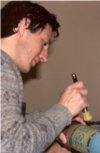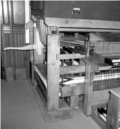The J. Edward Harris Memorial Organ
The Emora T. Brannan Chapel
Lovely Lane United Methodist Church, Baltimore, Maryland
Hilborne L. Roosevelt Opus 239 1885

This organ has always stood in its present location except when completely removed for the restoration. It was used for afternoon Sunday School and for daily services for Goucher College, which moved from premises nearby to the present Towson campus in stages over three decades ending in 1954. Its good fortune from the historian's viewpoint is that, on account of these secondary roles, it was spared rebuilding and alterations of significance. There are nine stops. Almost all the pipes are enclosed in a swell box, the exceptions being the lowest twelve notes of the Open Diapason and the entire Pedal Bourdon. The design is one of several presented in the maker's catalog. A distinguishing particular of this organ is the Flageolet stop. The casework is of chestnut. The overall quality of construction is remarkable.
| Disposition | ||
| Ped Bourdon | 16 ' | |
| Gedeckt | 16 ' | tenor c |
| Open Diapason | 8 ' | |
| Salicional | 8 ' | tenor c |
| Doppel Flöte | 8 ' | |
| Flute Harmonique | 4 ' | |
| Octave | 4 ' | |
| Nazard | 2 2⁄3 ' | |
| Flageolet | 2 ' | |
| Manual to Pedal | ||
| Manual Octaves | ||
| Tremulant | ||
| Two fixed combination pedals (un-named) | ||
| Manual: C to a''' (58 notes) Pedal: C to d' (27 notes) | ||
| Wind pressure 2 7⁄8 " Pitch: a=440 at 70.3°F | ||

Saint Cecilia
washing a
façade pipe
The most obvious result of restoring the organ is the appearance of the twenty-three façade pipes, twelve of which speak. As part of a broader project the church commissioned a detailed study and report on these pipes by historical paint analyst John Mosca. The refurbishing was all done in our workshop, and while it constituted but a fraction of the total work in restoring the organ - most of which was to rectify damage caused by excessive atmospheric dryness on the one hand and saturation with water from a defective roof on the other - it also was a project in its own right and was approached differently from the remainder of the work. Here, the effect of the original was re-created using modern materials specified by Mr. Mosca, which are expected to fade much more slowly than the originals had done. Of particular interest are the several different gold effects and the precise colors used. The pipes had been overpainted several times and many were dented. Complete removal of the underlying materials was deliberately avoided and some of the original workmanship can be seen on the backs of the pipes.

Yellow size and
stencil
The damage by water occurred chiefly during the 1960's, and is a consequence of the organ's location under what turned out to be a troublesome spot in the roof at the join of two units of the building. Among numerous affected parts were the windchests, some wood pipes, and manual keyboard. The chest table was not replaced in toto. The loose portions were separated from the still securely glued areas. With appropriate preparation of surfaces, the removed parts were glued back in place and new pieces of decades-old poplar were added to fill kerfs. The method used to true the sliders into a flat condition involved hand-planing one side while they were supported on sacrificial "plaster-beds". The second side was then machined with reference to the first side. The pallet box walls, which were glued to the grids, were sawn off by hand and the material augmented to the proper size before being reglued. The pallet sides of the grids were fully restored. Most channels of the pedal chest toeboard, which is of a "double sandwich" construction, exhibited leakage between them and were sealed by being filled with glue and then drained. Splits in wood pipes, mainly at the top ends, were accurately "kerfed" and new material glued in. The primary glue used throughout was hide glue.

New scroll on
a zinc pipe

Part of the
windchest table
Turning to the metal pipes, the smaller ones evidently had been made for cone-tuning, but in many instances trimming and scraping had not been done and, instead, the tops had been slit and somewhat mangled in the course of bringing them to pitch. The damaged portions were re-formed and the knife-slits repaired by soldering. A horizontal mark was then scribed at each vertical seam exactly a half-inch from the top, as a means of documenting the lengths. Cone tuning was done, including preparation by trimming and scraping. The largest front pipes, being mainly of zinc, presented the usual issues encountered where tuning scrolls are formed from the zinc itself. After a hundred years the metal was too brittle through and through for any tuning to be done without fracturing the material. In these cases zinc was cut away and common metal was set in, at the same time leaving evidence that this was not the original treatment.
The manual key ivories were removed and reglued. Some were missing: replacements were consolidated at the top notes. One drawstop, the Gedeckt 16', had lost its inlay. The casework incorporates a few re-made pieces of chestnut, selected for grain orientation, color and texture from salvaged historic material.
The re-dedication recital (May 19, 1985) was played by Peggy Marie Haas with pumping provided by a number of volunteers in turn. In addition to two hymns sung by all, the program included music by Robert Schumann, Mozart, Vierne, Benjamin Carr, Brahms, Philp Phile and Dudley Buck. The organ has never been substantially changed and may be regarded as simply a jewel from a historical perspective. At least some of the particular restoration procedures employed here would more than likely not be applicable in restoration of another organ in a different evolved state, and with different issues requiring solutions to be found. The remainder of this article discusses the means of raising the wind.

The cast iron
part requiring
a new pattern
The wind system includes two single-fold wedge-shaped feeders and a rectangular double-rise inverted-fold reservoir with inclined bottom frame, originally pumped by a water engine: no handle was provided. One feeder was discarded in 1917, when an electric blower was installed; along with several items of hardware. In the course of this work the missing feeder was reconstructed and other needed parts made, including several of cast iron: one - at the center of the rocking beam - called for a the making of a pattern. The internal layout suggests that hand pumping of this catalog model was envisaged being done from a position on the treble side of the case: but in this instance the access on that side is too confined to permit operating a pump handle. A drawstop labeled Bellows Signal was provided, even though its function - tapping the side of the case to "awaken" the pumping assistant! - was never needed. Today the drawstop controls a new electric blower, directly behind the organ. A special flap-valve has been provided where the wind trunk from the new blower connects with the bellows, so as to prevent the bellows from "seeing" the new wind trunk (or charging it with wind) when pumping by hand. Thus the original resonances and characteristics of the wind system are preserved as far as possible.

The removable
pump handle...
without case-
work
With the blower on, the valve toggles automatically to an open position, assisted by a spring suspended from the bellows top frame. This keeps it from any tendency to jitter when only a trace of wind is demanded. The valve reseats itself automatically if sufficient time is allowed when changing from electric to hand pumping (exhausting all wind). To cover occasions where exhausting the wind takes too long, resulting in the valve staying open, there is another non-return valve at the blower, but the effect then achieved by hand pumping (and the effort required) will be different. Hand pumping is done from a standing position on the bass side of the case. The way the building is configured, the space there also serves as a main pathway into the room: the solution adopted was to make the protruding portion of the handle removable. Removable or not, a pump handle would require a vertical slot in the case, but here the slot has been provided with a small door (cut from the surrounding panel) which renders it almost unnoticeable when it is closed; the door, which opens inwards, in turn calls for being opened through a full 180° to avoid the possibility of it interfering with the bellows top frame. Another element of compromise is the suspending of a bellows-height indicator just inside this opening rather than, in the more common way, on the outside of the case. Such an indicator is vital for the person pumping: and in practice demands his or her continuous attention! For the organist the same information is provided in a more elegant fashion by means of an "eclipse" wind indicator at the console. This is a reminder of how hand-pumping calls for at least a degree of harmony between organist and pumping assistant!
In order to accomodate pumping from the bass side a slight modification was made to the drawstop linkage for the Bourdon. So as to facilitate future interpretation, on the inside the newly-fabricated or modified metal parts have been painted in a distinct color: dark blue. The original control crank which was used to turn the water engine on and off remains in its original place, within reach of the organist.